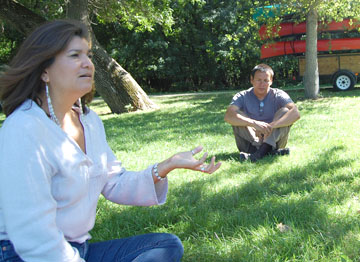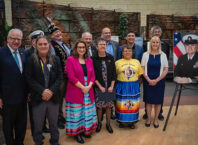{mosimage}
A growing chorus of indigenous cultural leaders agree that the reclamation of traditional lands – including prime real estate in the Twin Cities area– is crucial to solving the Dakota crisis.
Wyatt Thomas stood on the shore of Ogechie Lake, gazing down its distinctive hooked shoreline, lost in thought. He had never seen this lake before. He traveled to Mille Lacs County from Nebraska, where he lives on a reservation along the Missouri River as a member of the Santee Dakota Tribe. But Minnesota, and this lake in particular, was, to him, home.
Thomas was on a mission to scout his tribe’s ancestral lands, an expedition that covered a wide swath of Minnesota. It was a small but important first step in reintroducing the Santee Dakota to their original homeland.
“The lands and waters here are very sacred to us,” he said. “They have a meaning that no one else will understand. And in those meanings are the teachings that the creator has given Dakota people as a birthright.
” Turning to face the saddle-shaped burial mounds rising from the trees in the distance, Thomas identified the clearing between the shoreline and the woods as the village site of his direct forebear, Chief Wapahasa. “This is where we first lived before we were exiled.”
For centuries the Dakota Nation lived in this village and a handful of others along Wakpa Wakan (Holy River), the waterway that runs from Lake Mille Lacs (Mde Wakan, Spirit Lake) to the Mississippi River. In 1745, they were driven into the Minnesota and Mississippi river valleys by Anishinabe (also known as the Ojibwe or Chippewa) tribes invading from the east with French firearms.
Then, in 1863, the Dakota were forcibly removed again after a bloody five-week conflict known in textbooks as the Dakota Uprising.
Today the descendants of the expelled tribes live primarily on two reservations: the Nebraska location and the Crow Creek Reservation in South Dakota. Buffalo County, home to Crow Creek, is the poorest county in the United States, with a per capita income of $5,213. Unemployment stands at 57 percent and many homes lack plumbing and kitchen facilities.
The Santee Dakota Reservation in northeastern Nebraska – established in 1866 by Dakotas fleeing Crow Creek for more favorable living conditions – also ranks among the most impoverished communities in the United States. The Dakota who live on tribal lands in Minnesota are largely descended from “friendlies” – a small group of Dakota families who, following the U.S.-Dakota war, were deemed non-threatening and allowed to return. They established four tiny reservations that represent an infinitesimal fraction of their former Minnesota land base.
Compared to any other ethnic group in Minnesota, Dakota people experience shorter life spans, higher rates of infant mortality, higher incidences of diabetes, heart disease and cancer, and poorer general health. They also grapple with skyrocketing suicides. The suicide rate among American Indians in Minnesota is two to three times higher than any other ethnic group. Among American Indians in Minnesota ages 15–34, suicide is the second-leading cause of death. Suicide rates for American Indian youth between the ages of 10–15 are four times higher than those for all other races combined in this age group.Poverty and poor health are not the typical state of affairs for the Dakota. Prior to exile, they thrived in Minnesota, having developed a way of life based on a sophisticated understanding of the rich natural world around them.
They were canoe builders, farmers, healers, hunters and gatherers whose prosperity allowed them to develop a complex and enduring spiritual worldview, and a comfortable lifestyle that carried them through the long, harsh Minnesota winters.
Thomas believes that the only way for the Dakota to regain their former status as a prosperous, powerful and healthy nation is for his people to embrace their traditional culture. To that end he works with tribal elders on the Santee Reservation crafting a Dakota immersion curriculum with the hope that young tribal members will once again grow up speaking their native tongue.
Because the language evolved along the lakes and rivers of Minnesota, Thomas says it’s crucial to revitalization efforts that Dakota youth reestablish strong ties to their ancestral home. “Our language is almost gone,” he says. “It is fading away. Our ceremonies are being slashed, generation to generation. Some ceremonies are completely lost.”
Thomas is one voice in a growing chorus of indigenous cultural leaders who agree that the reclamation of traditional lands – including prime real estate in the Twin Cities area– is crucial to solving the Dakota crisis. Places like Lake Calhoun, Uptown, Loring Park, Nicollet Island, Minnehaha Creek, Lake Minnetonka, Harriet Island, Grey Cloud Island, Mendota and the picturesque and pricy Minnesota, Mississippi and St. Croix river valleys. There are innumerable forces working against the reclamation of Dakota Lands, but tribal leaders like Thomas say they must succeed – that the very future of the Dakota Nation hinges upon it.
“When I go home to Santee,” Thomas says, “I will tell the relatives that everything we seek for healing – the herbs, the medicines and the stones – are still there in Minnesota, and we must return to them. I will tell them to remember that all of Minnesota is Dakota land. Even though they took it from us, one day we will have it back. One day it will be ours again, when the time is right.”
Indian land is all around the Twin Cities. From the backyards of Bloomington to the white cliffs of St. Paul, Dakota bones lie beneath burial mounds. The names of the places bear Dakota names: Chief Wapahasa, gave us “Wabasha.” “Minneapolis” is a hybrid of the Dakota word for “water,” mni, and the Greek word for “city.” Wakpa Cistina (Little River)—now called Minnehaha (Waterfall) Creek – was once a jealously guarded trail that led Dakota people from the Mississippi River to villages, wild rice beds and ceremonial grounds on the secret inland sea, Mde Mni Ia Tanka (The Water They Speak of as Large, Lake Minnetonka).
Near I-494 and Post Road, where the growl of jet airplanes blasting off the international tarmac now makes bones tremble, one can still make out Taku Wakan Tipi (Dwelling Place of the Gods), the small earthen prominence known during pioneer times as Morgan’s Hill, believed to be home of Unktehi, god of the waters and underworld. The area is now home to a SuperAmerica.
Franklin Avenue in Minneapolis follows an ancient footpath that, for centuries, connected Dakota villages on Mde Maka Ska (White Earth Lake, today called Lake Calhoun) and Cedar Lake to Haha Wakpa (Waterfall River, the Mississippi). Today this ancient trail is home to the largest urban concentration of American Indians in the United States. If you look beneath the overpasses and behind the decorative roadside landscaping, you’ll find evidence of the illnesses created by the displacement of the Dakota people. Homelessness. Chronic alcoholism. Malnutrition. Diabetes.
You’ll also find, within the storefronts and office buildings lining the street, indigenous community members and professionals working for an alphabet soup of tribal organizations and non-profit agencies – DIW, OIC, MAIC, NACC, WIA, IHB, AIM – to solve the issues that accompanied the loss of indigenous lands to foreign invaders some 150 years ago.
Dr. Lydia Caros, a pediatrician, is one of the professionals along Franklin Avenue fighting these trends. For 26 years she has worked with American Indian mothers in the Phillips neighborhood. Formerly a member of the Indian Health Board Clinic’s medical team, Caros left seven years ago to help start the Native
American Community Clinic, a facility that allows her and other doctors to be creative in their treatment of a particularly unhealthy segment of the population. (The NACC runs the Running Wolf Fitness Center – a free workout facility – and offers nutrition classes and diabetes-friendly breakfasts, providing healthful foods to those for whom proper eating is a matter of life and limb).
Caros says her patients remain at the bottom rung of most health indicators because they’re overwhelmed with the challenges of adjusting to a lifestyle alien to the values of their culture.
“If people have terrible living conditions, if they’re in an abusive relationship, if they’re not sure how they’re going to handle their kids who are also struggling, if they don’t have transportation, they don’t know where the next money’s coming from to get food, then whether they’ve had a pap smear or an eye exam is not very important to them,” she says. “My patients tell me, ‘I have so much going on that I just can’t be bothered with that.’”
Caros is reinventing Native American health care. The federal Indian Health Service has adopted some of the NACC’s ideas as best practices in Native communities. And yet, Caros says, despite the efforts of its staff, the clinic has taken only baby steps in changing health habits community-wide.
Caros blames the usual suspects for this: poverty, lack of access to health care and racism. The clinic employs socials workers to help individuals deal with each of these. But to deal with the “core issue that pervades everything,” what Caros calls “that historical piece”– the trauma of dislocation and, in truth, genocide – the NACC opened a second facility last July: a mental health clinic. “That historic piece has never been dealt with, but it affects who they are, their relationships, and who they’ll become.”
It’s difficult for Caros to convince her patients to seek emotional therapy. She says American Indians are no quicker to accept an “invisible problem” than any other segment of the population. She tells her patients, “If you had an accident and broke your leg you would never walk around with it hoping it would get better. You would get help. It’s the same thing with emotional health; you can’t just walk around with it hurt and expect to do well.”
Valerie Larson works just down the Ancient Traders Market parking lot from NACC. For the past eight years, she’s been in the trenches of the health disparities battle, working for the state as Urban American Indian Health Coordinator for the Office of Minority and Multicultural Health. Larson says the Dakota people, due to the brutality of their historic treatment, are afflicted with a sort of collective post-traumatic stress disorder that “all the casino money in the world” can’t cure.
“Money can’t pay for what years of oppression by the federal government have done to the people,” Larson says. “When driven from your homeland, and your way of life that you held sacred, that your parents and grandparents and all your people that came before held sacred, when you are an exile in your own land, it changes you spiritually and mentally. So much so that you end up with an affliction akin to chronic depression.”
This knowledge is not just theoretical to Larson; it is also personal. Four years ago a young Dakota man, whom she had watched grow since birth, threw himself in front of a truck on a Leech Lake Reservation highway. “This was a 19-year-old who was very steeped in his traditions. He had been pipe carrier – the keeper of a family’s most sacred object – from the time he was four. He had a girlfriend, and they had a baby together. But he was so depressed that he jumped in front of a truck. We see this kind of thing all the time. They usually call these incidents accidental, but we know what is really happening. These are suicides,” said Larson.
A member of the Leech Lake Band of Ojibwe (Anishinabe) who has been married into a Dakota family for nearly a decade, Larson says Dakota people are up against a mountain of complex challenges unique to them as a tribal nation. The only solution, she says, is a return to traditional ways of being, which can only occur by reclaiming the land upon which the people once thrived.
“We need young people to return to the river valleys of Minnesota, and have elders out there with them who can call the plants and animals by their names, and to tell the old creation stories again. We need to help young people feel the magic of what it means to be a Dakota. Their disconnection from their own homeland is what’s causing all the problems, and it’s keeping them from being the Great Dakota Nation that they once were, and could be again,” said Larson.
In the valley of Wakpa Mni Sota (Minnesota River) the Dakota waged a war in 1862 against the United States, burning white settlements like New Ulm and Upper Sioux Agency to the ground. It was a desperate measure for the Dakota, who were starving even as government stores of food on their reservation overflowed.
After five weeks of combat, the surviving Dakota were rounded up and held in Fort Snelling before being shipped out of the state. The government imprisoned the Dakota men in a federal penitentiary in Iowa and later hanged 38 of them in Mankato. It remains that largest mass hanging in American history. The reverberations of that disastrous chapter in Dakota history can still be felt. For some Dakota people, the war seems like it was yesterday.
For others, like Waziyatawin (Upper Sioux Dakota), the war continues. On August 16, 2008, Waziyatawin (until recently went by her English name, Angela Cavender-Wilson) entered Upper Sioux Agency State Park during a reenactment of pioneer life circa 1858 – one of dozens of special events held around the state last year to commemorate Minnesota’s 150th birthday. She was handcuffed, dragged through the grounds by police officers, locked in a squad car and whisked away to Yellow Medicine County Jail in Granite Falls. The 40-year-old author and educator was booked for disorderly conduct.
The only way to redress the crimes of genocide the Dakota Nation has endured, Waziyatawin says, is through land reparations. In her latest book, What Does Justice Look Like? The Struggle for Liberation in Dakota Homeland (Living Justice Press, 2008), she calls for the return of millions of acres to the Dakota, an argument met with criticism from both sides of the mainstream/Dakota divide. Land reparations are unreasonable, they say. To which Waziyatawin responds:
“Before readers dismiss this option out of hand, let me point out that land reparations need not involve divesting white people of their private land holdings. In the state of Minnesota, for example, about 22 percent of the land area is identified as ‘public land.’ This includes federal agency lands, state agency lands, tax-forfeited lands, and metro commissioned lands, totaling 11,836,375 acres. That means Minnesotans and the federal government could return nearly 12 million acres of land to Dakota people tomorrow without touching a single acre of privately held land.”
Since her book was released late last year, Waziyatawin says she’s been approached many times by readers who call her demands extreme. “They ask me, ‘What’s your fallback position? What do you really want?’ And I tell them the position described in the book is the compromise. It means we’re giving up three-quarters of our homeland within the borders of the state of Minnesota today, and that is a tall price to pay.”
The author also demands all repatriated land be returned in pristine condition, so that Dakota people can use them as a base for subsistence hunting and gathering,
as they once did. She points out that all four Dakota reservations within the state of Minnesota are unusable for subsistence. Three of them (Upper Sioux, Lower Sioux and Shakopee) are along the Minnesota River, which has been classified as one of the five most polluted waterways in the United States. The fourth, Prairie Island, is home to an Xcel Energy nuclear power plant and its attendant radioactive waste.
Critics also take Waziyatawin to task because, at first blush, it seems she’s thriving under the current state of affairs. She is a university professor, she owns a home on the bluffs of the Minnesota River and has managed to send her children to college. Despite appearances, Waziyatawin says she hasn’t escaped the brutal inheritance of Dakota history.
“There isn’t a Dakota family that’s not been touched by issues of violence, physical abuse, sexual abuse, chemical dependency, poor health, early mortality and just hundreds of examples of racism,” she says. “My family is no exception. These social ills are what it means on a personal level to carry the legacy of genocide, ethnic cleansing and colonization.







